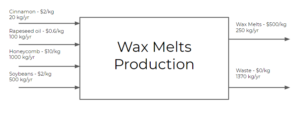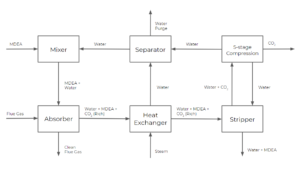10 Practice Exercises
Multiple Choice Questions
Exercise: Design Basis Memorandum
A client for a vinyl chloride production plant is looking to find information in the design basis memorandum you’ve provided on how long it will take to complete the plant construction. Where can the client look for this information in the DBM?
a) In the contractual issues section, under project scope
b) In the plant site-specific issues section, under site environmental conditions
c) In the design-specific issues section, under standards
d) In the contractual issues section, under deliverables and schedule
Solution
d) In the contractual issues section, under deliverables and schedule
The deliverables and schedule section of the DBM will contain a Gantt chart which can give the client information on
Exercise: Process Diagrams
You are upgrading the control system on a reactor and heat exchanger in the plant. You’d like to present these updates to a group of engineers and operators in your company. What would be the best type of diagram to present in this scenario?
a) P&ID
b) BFD
c) PFD
d) Input-Output
Solution
c) P&ID
For a technically-literate stakeholder group such as engineers and operators, it would be beneficial to present a process diagram with enough detail about the process and what streams and unit operations are involved. This requirement eliminates choices b and d. Given that this update focuses on the control system of the units, a PFD would not include this information. Therefore, a P&ID would be the best option for this scenario.
Exercise: Equipment Labeling
What information does the label TK-203B give you?
a) Storage Tank 2 in section 3B of the plant
b) Storage Tank 3 in section 2B of the plant
c) Storage Tank 2 in section 3 of the plant with other duplicate storage tanks
d) Storage Tank 3 in section 2 of the plant with other duplication storage tanks
Solution
d) Storage Tank 3 in section 2 of the plant with other duplication storage tanks
- First letter: equipment (TK = storage tank)
- First number: plant section (2 = section 2 of plant)
- Last numbers: equipment number (03 = storage tank 3 in this section)
- Last letters: show duplicates/triplicates when two or more of the same equipment is used for the same stage of the process.
Short Answer Questions
Exercise: Unit Operations
What sequence of unit operations can we use to mix the ingredients to make cookie dough, then divide the dough into equal portions, followed by baking to make a batch of cookies?
Solution
Mixer > Splitter > Reactor.
A mixer combines multiple process streams (separate ingredients) into one stream (one cookie dough). We can use a splitter to separate the dough into equal amounts. A splitter is different than a separater that a splitter divides the stream into streams with the same composition, while a separtor separates the stream into streams with different compositions. Finally, a reactor (oven) can be used to bake the cookies.
Exercise: Process Economics
Consider a company that has developed a process that produces cinnamon-scented wax melts used in spas, hotels, and homes for fragrancing. This company prides itself on making everything from the essential oil to the soy wax and beeswax in-house.

What is the gross economic potential of this process?
Solution
Recall that the gross economic potential (GEP) is:
GEP = Value of Products – Value of Feeds ($/yr)
The feed value can be calculated as follows:
- [latex]Cinnamon = 2\frac{$}{kg}*20\frac{kg}{yr} = 40\frac{$}{yr}[/latex]
- [latex]Rapeseed oil = 0.6\frac{$}{kg}*100\frac{kg}{yr} = 60\frac{$}{yr}[/latex]
- [latex]Honeycomb = 10\frac{$}{kg}*1000\frac{kg}{yr} = 10,000\frac{$}{yr}[/latex]
- [latex]Soybean= 2\frac{$}{kg}*500\frac{kg}{yr} = 1,000\frac{$}{yr}[/latex]
The product value can be calculated as follows:
- [latex]Wax Melts = 500\frac{$}{kg}*250\frac{kg}{yr} = 125,000\frac{$}{yr}[/latex]
- [latex]Waste = 0\frac{$}{kg}*1370\frac{kg}{yr} = 125,000\frac{$}{yr}[/latex]
Therefore, the GEP will be:
[latex]GEP = 125,000\frac{$}{yr} - (40\frac{$}{yr}+60\frac{$}{yr}+10,000\frac{$}{yr}+ 1,000\frac{$}{yr})[/latex]
[latex]GEP=113,900\frac{$}{yr}[/latex]
Exercise: Process Flow Diagrams
What is missing from the following process flow diagram (PFD)?

Solution
The following are missing from the PFD:
- The appropriate equipment labeling
- stream 7 content label (“HCl” in this case)
- Utility identification for the utility stream for heat exchanger (eg. steam, cooling water, etc)
Long Answer Questions
Exercises: Block Flow Diagram
Carbon capture is a process that is gaining a lot of attention due to its ability to mitigate the environmental effects in the oil and gas industry (along with other industries). One proposed carbon capture method is through the use of MDEA (N-methyl diethanolamine) absorption. The following steps describe the process:
- A stream of “Flue Gas”* is fed into an absorber
- An “MDEA + Water” stream is also fed into the absorber
- “The MDEA + Water” stream comes from a mixer where “MDEA” and a “Water” stream are fed
- A “Clean Flue Gas” stream and a “Water + MDEA + CO2 (Rich)” stream exit the absorber
- The “Water + MDEA + CO2 (Rich)” stream enters and exits a heat exchanger
- A “Steam” stream enters and exits the heat exchanger as “Water”
- The “Water + MDEA + CO2 (Rich)” stream enters a stripper
- A “CO2 + Water” exits the stripper
- A “Water + MDEA” stream also exits the stripper
- The “CO2 + Water” stream enters a 5-stage compression train where three streams (“CO2” and 2 “Water” streams) exit
- The first “Water” stream exiting the 5-stage compression and the “Water” stream exiting the heat exchanger are fed into a separator
- The second “Water” stream exiting the 5-stage compression enters the stripper
- Two streams (“Water Purge” and “Water”) exit the separator. This “Water” stream is the “Water” stream that is fed to the mixer
Draw a block flow diagram (BFD) for this process
*Flue gas: a gas stream exiting from an upstream process that usually consists of carbon dioxide, nitrogen, and oxygen (only nitrogen and carbon dioxide are considered for this process).
Solution



Feedback/Errata